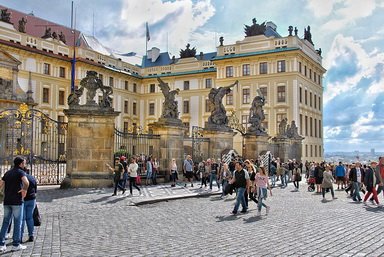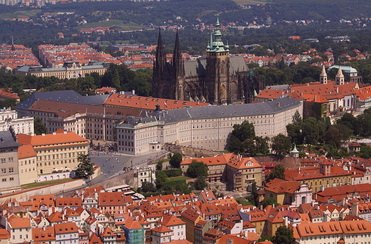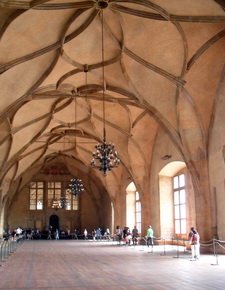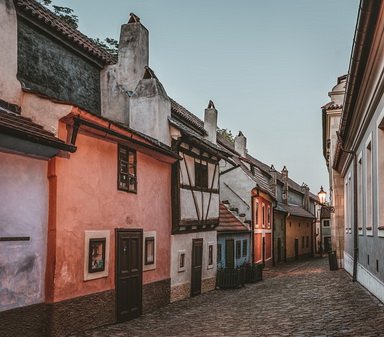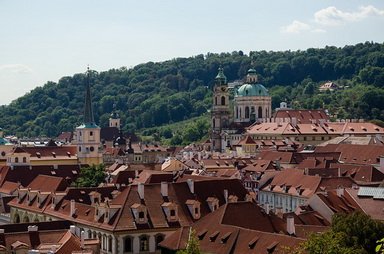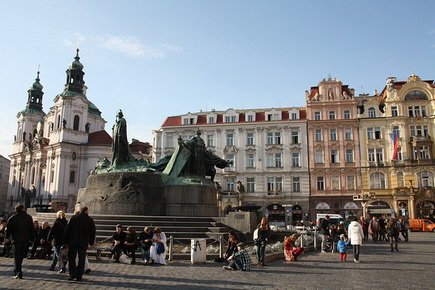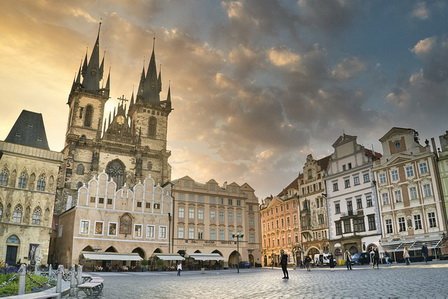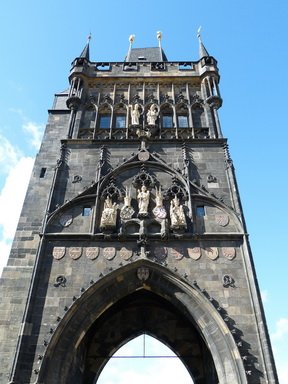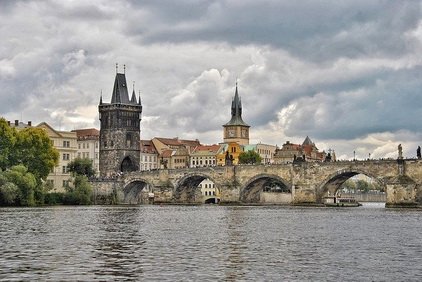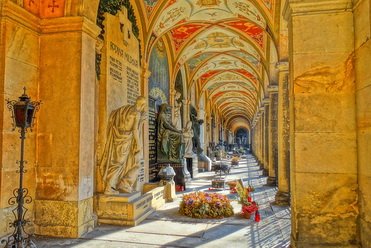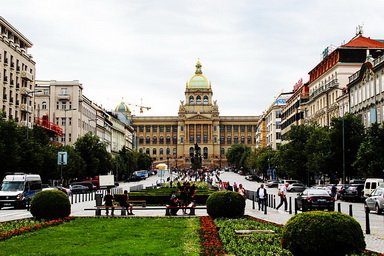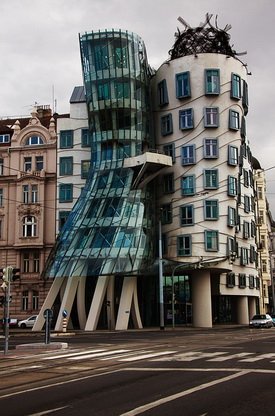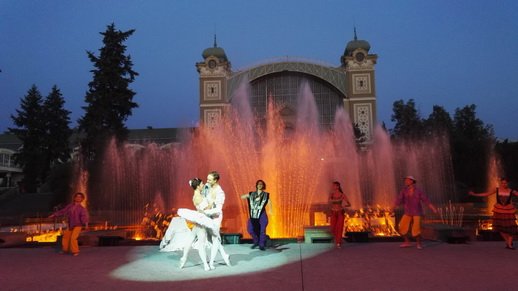Main attractions
View on the map
1 Hradcany Square
Whether at the beginning or at the end of your visit to the Castle Complex you are bound to find this place. The square lies in front of the main entrance to the Palace – you can see the Wrestling Titans guarding the doors called Mathias Gate. The tram or a bus will take you there, so you can conveniently enter the complex.
Look around before you do. The hill was a house not only to the seat of monarchic power. The bishop used to have a residence here. All the important decisions were signed here, and you are walking in the footsteps of the people who made them.
Swarzenberg Palace is probably the first to be noticed since the exterior façade is decorated in a fascinating, like-stonework way. It was all in accordance with the style of the 16th century – the renaissance. But the stones are an illusion, they were painted. The Palace looks grandiose, nevertheless. You can visit it inside since there is a National Gallery (weapons, sculptures, and art of the Renaissance and Baroque) there today. Look at the paintings on the ceiling from time to time.
The white, extravagant building next to the entrance to the castle complex is the Archbishop Palace. The ecclesiastical power moved from the castle to this building around the XVI century. The interiors are heavily decorated in the rococo style, but unfortunately, you cannot visit. Only the chapel of St. John the Baptist can be seen, but for a limited time and on certain days. People flock to it to see the Crucifixion painting – if not for its mastery, then for the gruesome story of its creation.
2 The Castle Complex
The Guinness book says that it is the biggest among all the others. It certainly takes a while to visit – you have an area of 74,000 m² to cover (Louvre has only 60000m²).
The castle was founded in the IX century and was largely finished in the XVth. Later, it undertook some renovations that made it more suitable for the Habsburg Empire. Because of these changes, it represents the styles from the medieval ones up to neo-classicism of the XVIII century. There are some palaces, museums, churches, gardens, and other interesting places inside. It will take you 3-5 hours to make a reasonable visit.
The adjacent gardens were commissioned by the Habsburg kings, who bought the neighbouring vineyards and turned it to a place for their leisurely walks. They also built their summer palace here and for some time the whole complex was the imitation of their Viennese seat of power. The gardens are free to visit, which makes them quite attractive. You can reach the Castle through Prasky Bridge next to the baroque riding school or by the street leaving from the Summer Palace.
3 St Vitus Cathedral
Apart from the majestic sight of the castle complex, the tower of the cathedral is the thing we notice immediately. It is not possible to imagine that it started as a wooden church and in the IX century was rebuilt into a roman rotunda.
It is dedicated to the patron saints of Bohemia – St Vitus, St Vaclav the king, and St Adalbert the bishop. They have been entombed here in the bohemian times and later the other kings joined them (even the Habsburgs were drawn here by their holy company). This Christian nucleus was turned into the imposing, gothic shape by king Charles IV. Not much has changed since then, although the church underwent many reconstructions. Peter Parler – the famous, local architect, didn’t finish the southern tower. But the renaissance addition is a strange and much-welcomed change – it enabled a construction of a viewing gallery which the tourists can enjoy for an additional price.
Visiting the interior is a near-mystical experience. The soul flies to the heavens with every vertical element, entrapped, only for a moment, by the beautiful ceilings. The stained glass gives color – even Alphonse Mucha created some of them (the story of Christianity in Prague in Archbishop Chapel). Here is where the Bohemian Regalia are kept safe. Both with the Golden Gate (depicting the moments of the Final Judgment) are the most popular attraction of the cathedral.
4 The Old Royal Palace
Although the complex was started to be built in the IX century, the hill housed a wooden stronghold before that. The Romanesque form of the palace was created later and is now known as the Old Royal Palace. Not much from the Middle Ages is still there. It was rebuilt many times over and became a part of a larger structure. Today you can find it in the southern wing of Hradcany Castle.
It was king Charles IV that created the bigger, gothic interior, but it was much later, that the most recognizable part of the palace was added. The Vaclav Hall with its magnificent ceiling the product of the XV century and king Vladislav Jagiełło. At these times there were banquets held here, ceremonial gatherings, even jousting! On horses! The so-called Riders Staircase was built in a way that the animals could climb it.
It is also here in the palace, not far from the Vaclav Hall that some Christian governors were thrown out of a window by the Protestants. Thirty Years War (XVII century) was started because of a religious quarrel, but it created a lot of political problems for the Habsburg Families all over Europe.
Enjoy the exhibitions of historical artifacts and art, and don’t forget to look around you. Kings walked these halls, the coat of arms on the walls tell the story of aristocrats and knights. The views from the balcony are almost the same as in the times when the gardens were created. And the overall architecture, plasterwork, and interior decoration are simply – beautiful.
5 Golden Lane
On your way out of the courtyard with St Vitus Cathedral you pass yet another church with a red façade. St George Basilica was the second temple of worship on the hill. It was built by Vlatislav I in the X century but was soon turned into a convent. Today it houses temporary galleries.
Walking the adjacent lane is in stark contrast to the courtyard you have just left. If you continue down the Jirska Street you will get out of the Castle Complex and, finally, down to Mała Strana. But turn left on this way to a wonderful Golden Lane. It is yet another street with dwellings from the XVI century. Back then they were the lodgings of the servants and the defenders of the Castle – the walls were just next to it. Later – artisans and goldsmiths moved in – they had plenty of work in the vicinity of the royal court.
The testimony of these times is guarded in the names and in the architecture of this street. You go in time in here. Looking at the shops you can almost see the signboards indicating what the occupation of the residents was…
Modern times are equally interesting. Although the beginning of the XX century was difficult, Golden Lane had its famous occupants. Under the number 22, Franz Kafka lived for a while (the author of Metamorphosis, his fantasy world is the answer to the realism of the beginning of the XX century). Number 14 was a house of a fortune teller that predicted the fall of the Third Reich. She was arrested and died – hopefully in the certainty of her foresight.
6 Mala Strana
At the feet of the castle lies a place that was once called the New Town. The city of Prague was created on the right side of the river and had the Castle Complex on the other side. But it was still quite a distance.
Prague and the Kingdom of Bohemia flourished, profiting from being a part of the Holy Roman Empire. In the XIII century, German settlers came to create the village under the castle. At first, it was a part of Prague – later, an independent city called Mala Strana. The closeness to the castle attracted the aristocracy, that wanted to live there. In the XV century, they bought most of the buildings. Their palaces are the home of many embassies today. It was the area where the rich lived – even Mozart used to play here.
If you manage to get out of the castle and get to the Castle Stairs (Zamkowe Schody) you will get the full scope of this district. Its white buildings, red roofs, and grandeur give an impression of an important place. The road will lead you to the Mała Strana Square and St Nicolaus Church. The baroque area is full of bars, restaurants, and souvenir shops, the church sometimes plays classical music concerts and the passing, old-style trams remind us of the industrial revolution. The atmosphere is one of a kind.
Follow the cobbled road and admire the nearby buildings of the square and adjacent – Mostecka Street (15-18 century buildings). It will lead you to Charles IV Bridge and the Old Town.
7 Old town Square
Being in Prague you are bound to find it. Apart from a popular tourist place, it is also a meeting point for the local population. The maze of the old town street is a perfect place to eat, have fun, or enjoy an evening walk in the light of the lanterns.
During the day there are plenty of tourists that come here for its attractions and stylistic eclecticism. The Old Town exists since the marketplace settlements of the IX century. It transformed to be a gothic, thriving city of Charles IV. Today we are amazed by the spires of the Town Hall and of the Church of Our Lady before Tyn.
In the middle of it, you will find the Memorial dedicated to Jan Hus – he brought the Reformation to these lands. Some crosses on the pavement mark the men killed here in aftermath of the religious wars of the XV century.
The renovated, colorful facades in renaissance and baroque styles, house shops, art, restaurants, and the National Gallery (Kinsky Palace). The signposts tell the story of the city where a building once had a name and not a number.
But the hero of this place is a clock…
8 Astronomical Clock on the Old Town Hall
The Town Hall of Prague is standing in the middle of Old Town Square. Not many realize that the adjacent, colorful buildings are a part of it. Everyone remembers only the gothic tower and the astronomical clock.
It is one of the oldest buildings in Prague, coming straight from the XIV century – this is when the tower and its chapel were built. As the city grew, so did the responsibilities of the city council. New space was required and so the neighboring tenements were slowly bought and adapted to its new function. Therefore, the Town Hall has this strange shape – it is not a single building.
The visitors can come inside and see the medieval foundations in the basement. The same goes for the chapel and the council halls. They are a mixture of gothic and renaissance styles, with beautifully decorated interiors, chimneys, coat of arms, and more. You can also climb the tower and get to see one of the best views of the city.
But everyone comes here for the astronomical clock called Orloj. It was added to the tower at the beginning of the XV century. At first, it was only a clock, but it grew with the reconstructions. At first, the architectural decoration was added and then the moving figurines (after XVI c) that we all look at today. The heart of the clock stays the same, but its face is a bit far away. It is difficult to see the details of the calendar, but you can see the Zodiac and the Earth sitting in the middle of the universe. It follows the old Czech time so do not set your clock after it.
Between 9 am and 1 pm the crowds gather in front of it. The spectacle of the apostles and the golden cock starts. The skeleton of Death strikes the time upon the full hour. The medieval heart still beating, the Enlightenment technology marching, and each new generation still amazed.
9 The Church of Our Lady before Tyn
Come to the square at night and you will think that there is a fairy-tale castle standing there. If it reminds you of something – check out the Disney Castle – maybe you will find some similarities. At least this is what the guides say…
The twin gothic towers are the most recognizable part of the church. They are visible from different parts of the town and the locals love it as much as the astronomical clock. It is immediately obvious that they are asymmetrical, which was not that common for the XV-century architecture. The bigger one is called Adam, in opposition to his sister – Eve. They both represent the masculine and feminine sides of the universe. They are both elegant, topped with dark helmets with 8 additional spires.
The insides are equally stunning. You can get there through the arcades of the Tyn school. The church is free (voluntary fee welcomed) to visit apart from the times when there are concerts. To put it simply – it is a gallery of gothic to baroque works. There is a chapel everywhere and each one is decorated in its own, characteristic style. The organs come from the XVII century and the stained glass adds to the overall atmosphere.
10 Towers – Powder Gate and Old Town Bridge Tower
Coming to Prague the tourist groups tend to start or finish on The Powder Gate. It stands on the East side of the Old town, marking the medieval frontier of the walls that were once here. It was constructed alongside 13 others. This one intended to be the start of the new era of prosperity – thus it was called the New Tower.
Wandering around the streets of the old town, shopping, or eating snacks, you are bound to find it. Its dark shape glooms over the pedestrians. But all in all – it is beautiful! It was largely inspired by the older tower built by Peter Parler next to the Charles IV Bridge, but the decoration is described as late Gothic.
Here started the procession of the Czech kings – up till today the tower marks the beginning of the Royal Route to Prague Castle. The way led to yet another tower – the older one.
It is easy to understand where the tower is since its name is the Old Town Bridge Tower. The most famous king – Charles IV ordered its construction. He did the same for the bridge of his name and the university. Back then it was the triumphant arch under which the Bohemian kings went to their castle.
Peter Parler designed it. It is adorned with the coat of arms of Bohemia – look for the lion on the red background. If you come from the direction of the town square you will notice statues above the arch. These are Charles IV on the right; Wenceslas IV on the left; and of St Vitus in the middle – the patrons of the town.
11 Charles IV Bridge
You will find Charles IV to be omnipresent in Prague – either as a name, in stories, or as a statue. This king of Bohemia became the Emperor of the Holy Roman Empire in the XIV century. He joined the line of rulers leading back to Charlemagne of Franks.
He could wage war but knew when to profit from the peace. Prague became his capital, he erected several buildings here, wanting it to become the Paris of Central Europe. He created the university – the first one in this part of the continent. The city then started to attract scholars, intellectuals, and people of power.
One of his projects included refurbishing the old bridge into a proper one. The Stone Bridge became the link not only between the castle and the city but also the only reasonable crossing for the merchants and travelers. The construction started in 1357 and lasted over 50 years. But the bridge was flood-proof and thus the medieval roads started to go through Prague.
The bridge is 518m long and 10m wide. It rests on 16 arches. It was so sturdy that even the heavy transport of the industrial revolution could cross it with no worries. Since 1978 it is a pedestrian bridge only.
The replicas of the original statues of saints and patron saints adorn it. They represent the baroque styles since they were added at the end of the XVII century. The originals were too precious, and they are now in the Lapidarium of the National Museum (metro C, Vldavska, or Holesovice stations).
12 Vysehrad
A 20-minute ride to the south of the Old Town you will find a hill and the castle of Vysehrad. According to the legends, this is where the Czech kingdom started somewhere between the IX and X centuries.
People living there were ruled by a wise old man called Krok. He wasn’t a king yet, but his daughter Libusza and prince Premysl became the first rulers of the forming nation. They gave birth to the Premyslid Dynasty and are responsible for the creation of Prague.
Since the town was foretold in the prophecy, the kings started to create a second castle nearby – this is how Hradcany started. But Vysehrad became their second home. Sometimes forgotten, sometimes beloved by the ruling family. Vratislav II kept the royal court there in the XI century, but we can safely say it was for the last time.
The castle became abandoned by royalty. Since then, it was renovated and destroyed either by time or by men. The Habsburgs made a baroque fortress out of it, but still – they preferred Hradcany.
It is a hill covered in legends, a place from the times when nature was the religion. You will find there the oldest in Prague rotunda from the XI century and a basilica… but you will also hear the stories of Three Furias and the Devil’s Column. The fortifications are massive since the castle holds its baroque form. They also offer great views and a chill down the spine on a misty morning. Especially if you are wandering around the Vysehrad Cemetery. It is like Pere Lachaise of Paris – all the famous people can be found here including the composer Antonín Dvořák, Alphonse Mucha, and the writer Karel Čapek.
If not for the architecture or statues – enjoy the views, a stroll, and the atmosphere of the place.
12 The New Town
It is only slightly younger than the Old Town, but 5 times bigger. Still, it was a separate town until the growth of the city turned it into a district. Charles IV has just become the emperor and he had chosen Prague as the place where he would reside. Founding the New Town was meant to augment the status of the older city. It was further beneficial, because of the housing problem.
It was only the beginning, but the growing Prague and its university started to attract more and more newcomers. It was also a perfect idea if the king wanted to make a second Paris. The square of his name is the biggest one in the world! It must have been a wonder in medieval times. There was a cattle market here, and a horse one on yet another square – we know it as Venceslav Square today. Charles would be happy to know that it is sometimes compared to the Champs Elysee. It is a popular gathering place, but not only for the demonstrations that often start under the St. Vencelsav horse statue. People come here for walks, to the restaurants and bars, to do some shopping.
Not far from there you have hotels, opera and the National Museum (a 10-minute walk from the Main Train Station). The collection of this XIX century building started like all the others – with the private collection of Count Sternberg (a botanist and a mineralogist). Today there are over 14 million items from the areas of natural history, mineralogy, paleontology, zoology, anthropology, archaeology, history, arts, and music.
You will have to look for it, but you may also want to see the colorful Jerusalem Synagogue with striking architecture. The Dancing House (1996) not far from the river and Jiraskuv Bridge is fascinating. You can almost see Fred Astaire wearing a white suit, holding Ginger Rogers in her glass dress. Or you can call it a Drunken House, as the locals.
More contemporary times give you the head-sculpture of Franz Kafka. The monument to this famous writer stands right next to a shopping center. What is so unique about it is that it is moving. The 11m head is made of horizontal panels that rotate. It is absolutely amazing and if you have time, you should definitely have a look.
12 Leisure
If you have more time in Prague, you should think about the following.
Petrin Tower is a remnant of the World Expo of 1889. It stands on the hill, some say it looks like the Eiffel Tower and there is a park surrounding it. Half hour walk on the steep stairs will be worth it since the views from there are stunning.
The Boat Trip on the Vltava River is also a great option. It was she that attracted the settlers to come here. It was she that gave money to the city after building a suitable crossing. It is she that is described in Czech poems and songs. The tours last about an hour unless you take the one offering dinner. The most popular starting place is close to the Czech (Cech) Bridge, but there are other points along the Vltava.
The metal building of the Industrial Palace was created for the Jubilee Expo of 1891. It is a perfect background for the spectacle happening next to it. Krizik Fountains are both a water spectacle, music show, and dancing performance. There will be a lot of classical music, which goes perfectly with the ballet happening on the stage. In the summer months it still may be chilly and since these are the evening events – remember to take some extra clothing.
Top 10 list
- Walking the streets of the Old Town
- Orloj performance
- Charles IV Bridge
- St.Virus Cathedral
- Golden Lane
- Jewish Quater
- Venceslas Square and shopping arcades
- Enjoying the nightlife
- KGB Museum
- Lennon Wall (cause we’re fans)

